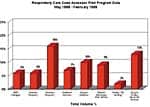RTs Assume a Key Role in Patient Care

At New York Presbyterian Hospital (NYP) in New York City, respiratory therapists play an active part in patient care, moving beyond their traditional roles to expanded duties that make use of their special skills. In recent months, RTs at the hospital have helped to reduce patient time on ventilators, have stepped in to ease a critical care nursing crunch, and have been instrumental in developing new policies for extubating patients. “Here, we’re really considered part of the solution and not part of the problem,” says the director of respiratory care, Octavio “Michael” Lafuentes, RRT.
A TRADITION OF SPECIALIZED CARE
Weill Cornell Medical Center was founded in 1932. In 1998, it merged with Columbia Presbyterian Medical Center to form New York Presbyterian Hospital. Affiliated with Columbia University Health Sciences and Weill Cornell Medical College, New York Presbyterian has grown to be one of the premier teaching hospitals on the East Coast. The hospital is known for specialty care for AIDS, cancer, children’s health, women’s health, cardiac care, gene therapy, and its burn center. New York Presbyterian Hospital has 2,369 beds, serves more than 93,000 inpatients per year, and treats more than a million outpatients annually.
At NYP’s New York Weill Cornell Medical Center campus, 46 RTs work in eight specialized areas: the burn unit, pediatric intensive care unit (ICU), neonatal ICU, medical ICU, medical step-down unit, cardiothoracic ICU, medical cardiac care unit, and surgical ICU.
The hospital’s William Randolph Hearst Burn Center played a vital role in caring for victims of the terrorist attacks on the World Trade Center. “We have 20 ICU beds in the burn unit and during 9-11 every bed was filled with vent patients because of the World Trade Center disaster,” Lafuentes says. “I was really impressed with the cooperation between respiratory therapists and nursing, physicians, clerks, social workers—everybody. We were really tested and I think we came through with flying colors, which says a lot for the institution and its preparedness.”
EXPANDING THE ROLE OF RTS
Under the direction of Joseph T. Cooke, MD, associate director of medical critical care and chairman of the Respiratory Care Committee, RTs have seen their role at NYP expand in recent years. “I think we have a lot of very good people working for us and I think in the past their expertise has been underutilized,” Cooke says. “They’re trained to do a lot of different things, but they’ve been somewhat hamstrung by hospital policy. In my tenure here, I’ve been trying to expand the role of respiratory therapists.”

Last year, NYP established ventilator management teams. The teams, comprised of a pulmonologist, internist, RT, nurse, social worker, and physical therapist, meet daily to assess the plan of care for ventilator patients. “All the disciplines are there and it’s an example of great cooperation,” Lafuentes says. “It allows the therapist to be involved in the plan of care and ultimately the outcome of that care.”
A recent study showed that since implementation of the ventilator management team, the number of days tracheostomy patients were on ventilators has been decreased by a week.
Another new hospital policy has an RT present whenever a patient is extubated. According to Cooke, this increases the safety of the patient and helps the medical residents to feel more comfortable as well, knowing an experienced person is there to back them up.
RTS HELP RELIEVE NURSING SHORTAGE
Like hospitals across the country, NYP has been struggling to hire enough qualified nurses. The nursing crunch was being particularly felt in the ICUs. In order to help alleviate this nursing shortage, as well as to enable RTs to utilize more of their skills, a recently completed pilot program had RTs in the ICUs take over respiratory care jobs formerly handled by nurses such as suctioning and ventilator changes. “The therapists are taking on more responsibility in terms of day-to-day management of the patient’s airway,” Cooke says. “Now the therapists are more involved as part of the care team instead of just being someone pushing a ventilator around.”

Initially, there was some concern that nursing would resent this move into what had been its territory, but this has not been the case. The pilot program was so successful, it has been approved as a permanent change and will soon be expanded to the medical step-down unit.
RTs have also become more involved with patient education at the hospital. Therapists are helping to train patients and their families in the use of metered dose inhalers, cutting down on reliance on nebulizer therapy.
KEEP THERAPISTS CHALLENGED
Surveys have shown most therapists like these changes and enjoy the new challenges and chances to use their skills. The new opportunities are also helping to reduce turnover in the respiratory therapy department. “Before, we couldn’t keep younger, more enthusiastic therapists because they wanted to do more,” Cooke says.
RTs at NYP have a number of opportunities to improve and add to their skills, through in-house continuing education classes. Therapists also make presentations to their peers, such as classes on hyperbaric therapy conducted by RTs.
The hospital is affiliated with Borough Manhattan Health Community College. Respiratory therapy students from the college train at NYP and many go on to work there after graduation, which means a steady supply of qualified applicants for the respiratory therapy department.
The department strives for continuity of patient care among all shifts. “Our therapists are competent to deliver all modes of therapy on all shifts,” Lafuentes says. “Everybody comes up to the high standards of the department and has the same level of competency.”
STATE-OF-THE-ART TECHNOLOGY
The hospital supports the respiratory therapists with state-of-the-art ventilators and other equipment. Lafuentes reports he recently had a $400,000 capital acquisition budget approved.

A Respiratory Care Committee, headed by Cooke and made up of doctors, nurses, physical therapists, epidemiologists, and RTs, meets monthly to discuss the role of respiratory care in the hospital. “Meeting monthly, I get to speak to all the heads of all the units and the nurses and everyone involved,” Lafuentes says. “We can deal with any problems right away.” Equipment needs are addressed by a Equipment Technology Committee, which has a representative from respiratory therapy as a member.
In his 32 years at the hospital, Lafuentes has seen the biggest changes in technology and the addition of sophisticated therapies. The hospital has been providing nitric oxide therapy since 1995, one of the first facilities on the East Coast to do so. It provides hypoxic gas therapy for infants with hypoplastic left heart syndrome and is currently setting up a ventilator to administer isoflurane, an anesthetic gas for relief of bronchospasm.
Eight RTs work with the hospital’s hyperbaric chamber in the burn unit. “Therapists are constantly being challenged by the physicians to deliver new modes of therapy,” Lafuentes says.
In the near future, Cooke hopes to establish an extracorporeal membrane oxygenation (ECMO) team with RTs as an integral part of the team. He is also hoping RTs will be able to become more involved in research.
For RTs at NYP, every day holds new challenges and opportunities to be an important part of patient care. As Lafuentes says, “In these difficult times, when competition is so fierce and all departments are under a microscope, we really continue to meet the challenges that are presented to us.”
Cynthia Myers is a contributing writer for RT Magazine.








